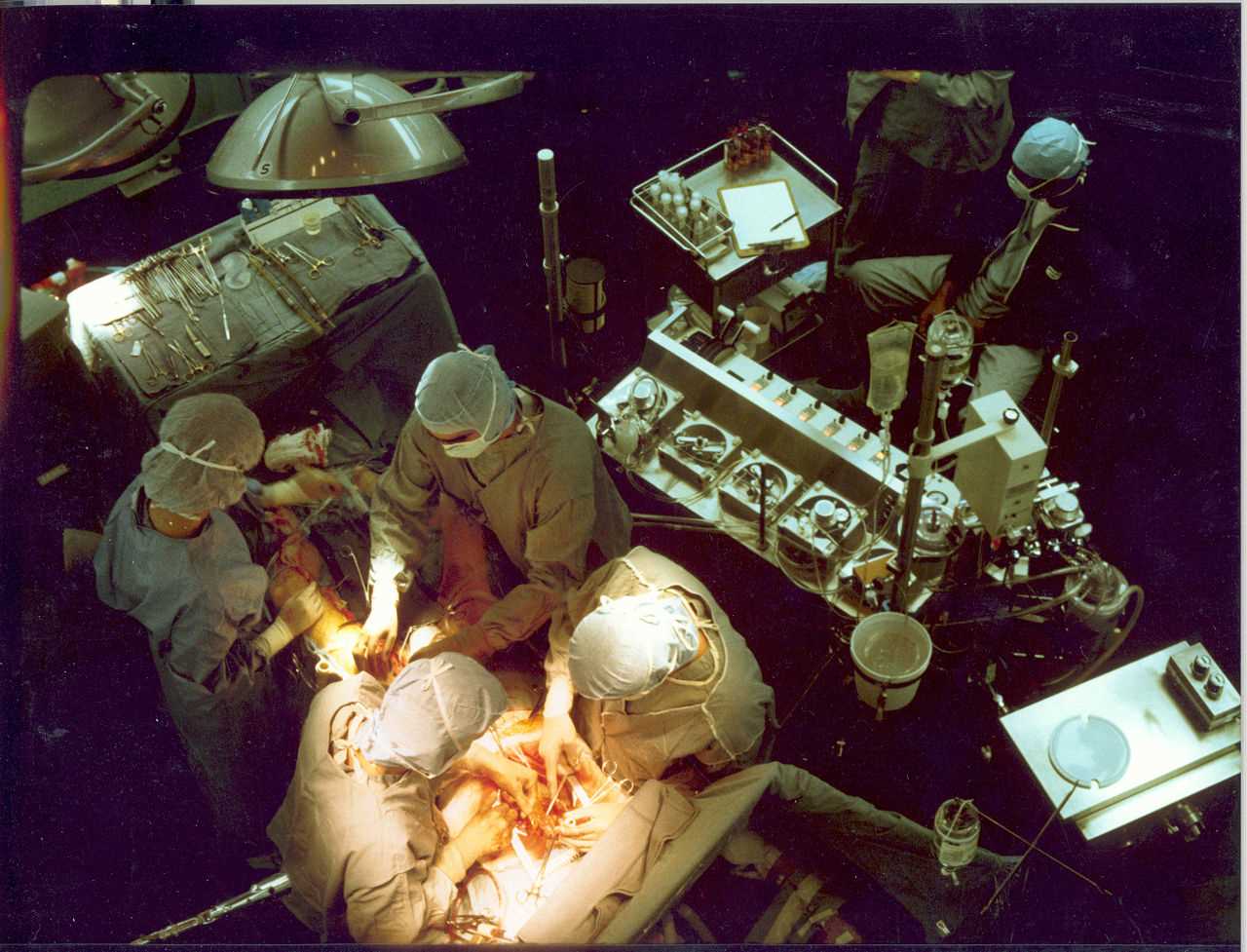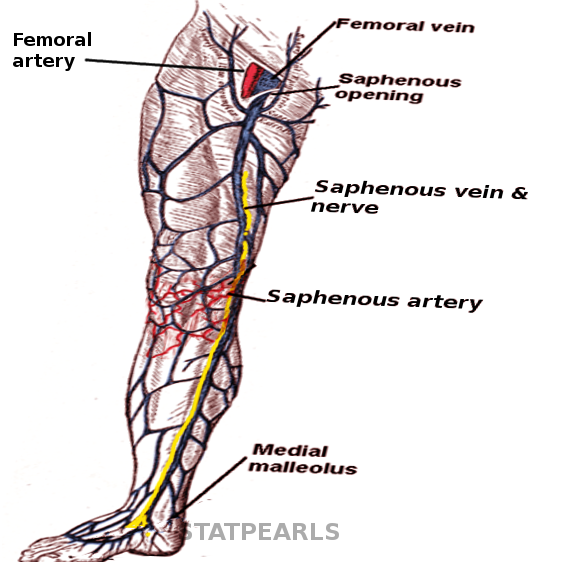[1]
Zingaro C, Cefarelli M, Berretta P, Matteucci S, Pierri M, Di Eusanio M. Endoscopic vein-graft harvesting in coronary artery bypass surgery: Tips and tricks. Multimedia manual of cardiothoracic surgery : MMCTS. 2019 Jul 9:2019():. doi: 10.1510/mmcts.2019.019. Epub 2019 Jul 9
[PubMed PMID: 31290620]
[2]
Allen K, Cheng D, Cohn W, Connolly M, Edgerton J, Falk V, Martin J, Ohtsuka T, Vitali R. Endoscopic Vascular Harvest in Coronary Artery Bypass Grafting Surgery: A Consensus Statement of the International Society of Minimally Invasive Cardiothoracic Surgery (ISMICS) 2005. Innovations (Philadelphia, Pa.). 2005 Winter:1(2):51-60
[PubMed PMID: 22436545]
Level 3 (low-level) evidence
[3]
Li G, Zhang Y, Wu Z, Liu Z, Zheng J. Mid-term and long-term outcomes of endoscopic versus open vein harvesting for coronary artery bypass: A systematic review and meta-analysis. International journal of surgery (London, England). 2019 Dec:72():167-173. doi: 10.1016/j.ijsu.2019.11.003. Epub 2019 Nov 9
[PubMed PMID: 31707009]
Level 1 (high-level) evidence
[4]
Kim DY, Song H, Kim HW, Jo GH, Kang J. Early Outcomes of Endoscopic Vein Harvesting during the Initial Learning Period. The Korean journal of thoracic and cardiovascular surgery. 2015 Jun:48(3):174-9. doi: 10.5090/kjtcs.2015.48.3.174. Epub 2015 Jun 5
[PubMed PMID: 26078923]
[5]
Portugal IB, Ribeiro Ide L, Sousa-Rodrigues CF, Monte-Bispo RF, Rocha AC. Distribution of saphenous vein valves and its practical importance. Revista brasileira de cirurgia cardiovascular : orgao oficial da Sociedade Brasileira de Cirurgia Cardiovascular. 2014 Oct-Dec:29(4):564-8. doi: 10.5935/1678-9741.20140038. Epub
[PubMed PMID: 25714210]
[6]
Cheatle T. The long saphenous vein: to strip or not to strip? Seminars in vascular surgery. 2005 Mar:18(1):10-4
[PubMed PMID: 15791547]
[7]
Bonde P, Graham AN, MacGowan SW. Endoscopic vein harvest: advantages and limitations. The Annals of thoracic surgery. 2004 Jun:77(6):2076-82
[PubMed PMID: 15172271]
[8]
van Diepen S, Brennan JM, Hafley GE, Reyes EM, Allen KB, Ferguson TB, Peterson ED, Williams JB, Gibson CM, Mack MJ, Kouchoukos NT, Alexander JH, Lopes RD. Endoscopic harvesting device type and outcomes in patients undergoing coronary artery bypass surgery. Annals of surgery. 2014 Aug:260(2):402-8. doi: 10.1097/SLA.0000000000000377. Epub
[PubMed PMID: 24368640]
[9]
Manetta F, Yu PJ, Mattia A, Karaptis JC, Hartman AR. Bedside Vein Mapping for Conduit Size in Coronary Artery Bypass Surgery. JSLS : Journal of the Society of Laparoendoscopic Surgeons. 2017 Apr-Jun:21(2):. doi: 10.4293/JSLS.2016.00083. Epub
[PubMed PMID: 28439192]
[10]
Mahmood D, Rosati F, Petsikas D, Payne D, Torkan L, Bisleri G. Endoscopic saphenous vein harvesting with a non-sealed approach. Multimedia manual of cardiothoracic surgery : MMCTS. 2019 Apr 9:2019():. doi: 10.1510/mmcts.2019.009. Epub 2019 Apr 9
[PubMed PMID: 30990577]
[11]
Brown EN, Kon ZN, Tran R, Burris NS, Gu J, Laird P, Brazio PS, Kallam S, Schwartz K, Bechtel L, Joshi A, Zhang S, Poston RS. Strategies to reduce intraluminal clot formation in endoscopically harvested saphenous veins. The Journal of thoracic and cardiovascular surgery. 2007 Nov:134(5):1259-65
[PubMed PMID: 17976458]
[12]
Chernyavskiy A, Volkov A, Lavrenyuk O, Terekhov I, Kareva Y. Comparative results of endoscopic and open methods of vein harvesting for coronary artery bypass grafting: a prospective randomized parallel-group trial. Journal of cardiothoracic surgery. 2015 Nov 12:10():163. doi: 10.1186/s13019-015-0353-3. Epub 2015 Nov 12
[PubMed PMID: 26563714]
Level 2 (mid-level) evidence
[13]
Ma GT, Liu XR, Zhang CJ, Liu JZ, Miao Q, Jiang C, Mao R. [Endoscopic Saphenous Vein Harvesting versus Open Vein Harvesting Techniques]. Zhongguo yi xue ke xue yuan xue bao. Acta Academiae Medicinae Sinicae. 2015 Aug:37(4):420-3. doi: 10.3881/j.issn.1000-503X.2015.04.009. Epub
[PubMed PMID: 26564458]
[14]
Raja SG, Sarang Z. Endoscopic vein harvesting: technique, outcomes, concerns & controversies. Journal of thoracic disease. 2013 Nov:5 Suppl 6(Suppl 6):S630-7. doi: 10.3978/j.issn.2072-1439.2013.10.01. Epub
[PubMed PMID: 24251019]
[15]
Suarez-Pierre A, Terasaki Y, Magruder JT, Kapoor A, Grant MC, Lawton JS. Complications of CO(2) insufflation during endoscopic vein harvesting. Journal of cardiac surgery. 2017 Dec:32(12):783-789. doi: 10.1111/jocs.13249. Epub 2017 Nov 23
[PubMed PMID: 29169212]
[16]
Deppe AC, Liakopoulos OJ, Choi YH, Slottosch I, Kuhn EW, Scherner M, Stange S, Wahlers T. Endoscopic vein harvesting for coronary artery bypass grafting: a systematic review with meta-analysis of 27,789 patients. The Journal of surgical research. 2013 Mar:180(1):114-24. doi: 10.1016/j.jss.2012.11.013. Epub 2012 Nov 28
[PubMed PMID: 23218736]
Level 1 (high-level) evidence


